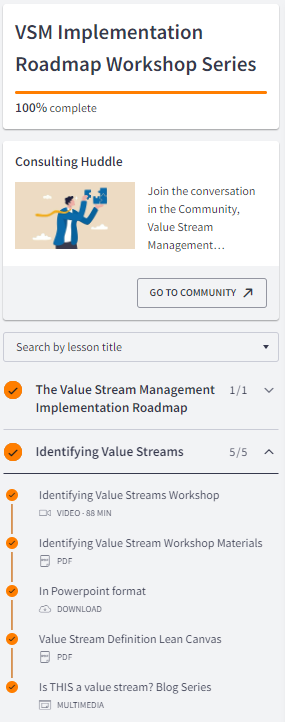“A value stream is the end-to-end set of activities that delivers particular results for a given customer (external or internal)”
- James Martin, 1995
Value stream identification is a process of discovering and defining the interconnected value streams that make up a modern organization. It helps us understand where work is done in the context of customer outcomes, where to assess and investigate performance, and how to optimize the delivery of value to customers. Value stream identification is especially important for leaders who want to adopt digital value stream management to improve visibility, collaboration, and governance across value streams.
In this article, we’ll cover some of the principles of value stream identification that can help you get started with value stream thinking, mapping, and strategy.
If you’re interested in learning about the specific examples shaping these principles, check out our other articles in the series:
- Is Incident Management a Value Stream?
- Is Release Management a Value Stream?
- Is a Customer Journey a Value Stream?
- Is Platform Engineering a Value Stream?
- Is Onboarding a Value Stream?
Why Collect Principles of Value Stream Identification?
"As to methods, there may be a million and then some, but principles are few.
Those who grasp principles can successfully select their own methods."
- Harrington Emerson
Every organization is different. Different missions, organizational structures, operating models, and the list goes on. Value Streams give us a useful framework for understanding not only how they work but how they should work. Using a value stream model, we can identify not only what it takes to deliver value, but also everything unnecessary or wasteful. We can recognize the contribution of key capabilities, and see the interdependence of separate workflows.
That sounds great, but it begs the question: “Where are these value streams?”
“Value shall be specified from the standpoint of the customer. A value stream shall be identified for each product or service family – from concept to launch and from order to delivery”
- Mike Rother, 2003
In a modern enterprise comprised of knowledge work and digital activity, where the flow of bits and information is more important than raw materials - the value streams are invisible. We can follow it from inception to realization if we sit with the workers, but today’s value streams of decentralized knowledge work exist primarily in a logical model. Even so, regardless of the challenge of visualizing and defining a value stream network, the juice is well worth the squeeze. In my experience, teams that map their value streams uncover quick wins reducing waste by 20%. Without a model for defining work as value streams; it’s too easy for constraints, dependencies, and waste to remain hidden, micro-optimization and siloed work to run rampant, and customer value to stay detached from individual contributors.
We’re providing principles for identifying value streams to make the implementation journey easier and accelerate your efforts toward high-performance value stream management.

The VSM Implementation Roadmap
To see your organization as a value stream network, you need a clear methodology for ‘seeing’ (defining) the streams. Before you can improve flow, you need to be able to see it and measure it. This guide will help you identify your value streams so that you can start to benefit from less waste, higher performance, and a greater sense of clarity and ownership over the system of value delivery in your organization.
Principles of Value Stream Identification
In 1995, James Martin defined a value stream as “the end-to-end set of activities that delivers particular results for a given customer (external or internal)”. In 2023, we’re increasingly focused on digital value streams, and these principles directly address that evolution.
Definition (What is a value stream?)
- A value stream is just a pattern. Where this pattern appears, you can apply a consistent set of practices. Value streams are the simplest pattern that constitutes a complete business process: a repeatable relationship between a supplier and a customer. Identifying a value stream means learning to see this pattern even when it unfolds over time and is hidden by inefficiency and inconsistency.
- Where there is a customer, there is a value stream: Value implies a customer who experiences that value. The stream is how value is enabled and protected. The customer can be either internal to the business or external.
- A digital value stream is a series of activities that produces a digital product, platform, service, or experience: Beginning with an idea and finishing with a delivered customer outcome.
- A value stream represents a system of work in the context of a customer. A system is something whose defining properties emerge from the relationship between its components. A value stream is necessarily a feedback loop between customer and supplier, where the coordinated actions of the supplier satisfy customer demand and trigger repeat business. As with most systems, you cannot see a value stream directly, but you can visualize it through mapping and measuring interconnected work processes. That in turn enables holistic optimization.
- Every organization contains a network of value streams serving customers: Mapping this network of value streams reveals the structures that support customer outcomes and business viability, an insight not provided by its organizational chart.
- No stream is independent: Core streams are why you’re in business - they drive & motivate a customer journey. Supportive streams enable core and/or other supportive streams to perform and deliver.
Methodology
- Your goal shapes what you see: Starting with a specific pain, need, or customer outcome helps you identify the relevant streams, and measure just what matters most.
- Think holistically: Think from business hypothesis to customer satisfaction (or Hypothesis-to-Happiness in short), upstream to downstream, and within a network of interdependent streams. See the forest and the trees.
- Working backwards is easier than forwards: From a given customer outcome, you can discover the stream by asking: “What happened to deliver that?” until you get to inception. Working forwards can send you following a number of paths to varied outcomes.
- Value streams can exist inside a mess. One person may have many responsibilities, each of which contributes to different value streams. There may be enormous variability, and long delays between stages, which can confound attempts to identify value streams precisely. Remember, value streams are patterns, not absolutes.
Benefits
- By identifying value streams, you can effectively manage them: Identifying a value stream reveals the structure you need to optimize to achieve sustainable, systematic performance improvement. The bottom line of value stream management is enabling better customer, business, and contributor outcomes over a long time horizon.
- Map for discovery and validation: Value chain maps can reveal an interdependent network of streams, value stream mapping can reveal the structure & dynamics of a single stream. Mapping allows you to validate and share your model with others.
Join us to collaborate in our Consulting Huddle to advance the future of VSM and develop our VSM Implementation Roadmap materials

Want more? Become a Value Stream Management Consortium member and get access to the VSM Foundation course.
Picture credits: Shutterstock

Steve Pereira
Steve is obsessed with making tech human, and leveraging it to deliver continuous value. For the past 20 years, his focus has been guiding ambitious and struggling teams towards their true north. He's a former startup CTO, agency consultant, systems and release engineer, finance IT manager, tech support phone jockey, and pizza maker. All focused on the flow of value, all the time.








Comments 1